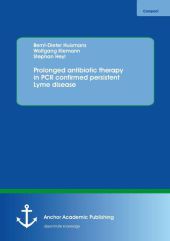 Neuerscheinungen 2014Stand: 2020-02-01 |
Schnellsuche
ISBN/Stichwort/Autor
|
Herderstraße 10
10625 Berlin
Tel.: 030 315 714 16
Fax 030 315 714 14
info@buchspektrum.de |

Bernt-Dieter Huismans
Prolonged antibiotic therapy in PCR confirmed persistent Lyme disease
Erstauflage. 2014. 24 S. 220 mm
Verlag/Jahr: ANCHOR ACADEMIC PUBLISHING 2014
ISBN: 3-9548924-1-3 (3954892413)
Neue ISBN: 978-3-9548924-1-9 (9783954892419)
Preis und Lieferzeit: Bitte klicken
We examined a sample of 90 individuals that had previously received a course of appropriate antibiotics for Lyme disease without experiencing full resolution of their symptoms and had evidence of persistent infection documented by PCR analysis. Mean duration of symptoms was 9.5 years (range 1 - 40 years). The treatment was adapted to the individual case according to clinical response. Long term antibiotic therapy was initiated and patients were treated continuously for at least 6 months, in some cases several years of intermittent therapy was administered. About 38.8% of the patients experienced full remission of symptoms while about 56.7% reported a significant improvement, 5.6% of patients were deemed refractory to therapy. Therapeutic modalities are discussed in detail.
Chapter Introduction:
Lyme disease was first described as an independent entity by Allen C. Steere et al. in 1977. Since then we have learned that this complex illness is the result of an infectious process that not only affects the skin and joints but can potentially disseminate systemically. Although 30 years have passed since the discovery of the disease, the available data on therapy still has to be considered sparse. In a review article published in 2006 D. Hassler summarized the available data on the treatment of lyme disease and commented on the paucity of evidence. Only a few controlled studies and some in vitro observations are available. Nevertheless certain standards have been established and have made their way into treatment guidelines. Two currently available guidelines are widely accepted, one is published by the Infectious Diseases Society of America (IDSA), the other by the International Lyme and Associated Diseases Society (ILADS). The two guidelines propose strikingly different approaches for the treatment of late stage Lyme disease.
Previous studies usually included patients that were diagnosed with Lyme borreliosis based on clinical and serologic findings most of which were in an early stage of the disease. These serological criteria were introduced primarily for epidemiologic purposes reasons and lack sensitivity for clinical use. It is doubtful whether results obtained from these studies can be generalized and applied to other cases of lyme disease. Articles that document cases diagnosed by detection of borrelial DNA have, to our knowledge, been limited to case reports and case series. For this article we have gathered a large number of patients that were diagnosed with late stage lyme disease based on clinical and serological findings as well as direct evidence of the causative microorganism by using polymerase chain reaction (PCR). We provide long term follow up on the clinical course and treatment of these patients and evaluate the efficacy of prolonged courses (range 6-60 months) of antibiotics in these patients.
Wolfgang Klemann, MD, Leopoldstr. 17, 75172 Pforzheim, Germany, Phone: +49 (0)7231 313159, Fax + 49 ( 0)7231 106161, Email: w.klemann@dr-w-klemann.de, Bernt-Dieter Huismans, MD, Am Haldenberg 24, 74564 Crailsheim, Germany, Phone: +49 (0)7951 26 33 0, Email: BHuismans@t-online.de, Stephan Heyl, MD, Primelweg 13, 71229 Leonberg, Germany Email: stephan.heyl@googlemail.com.


